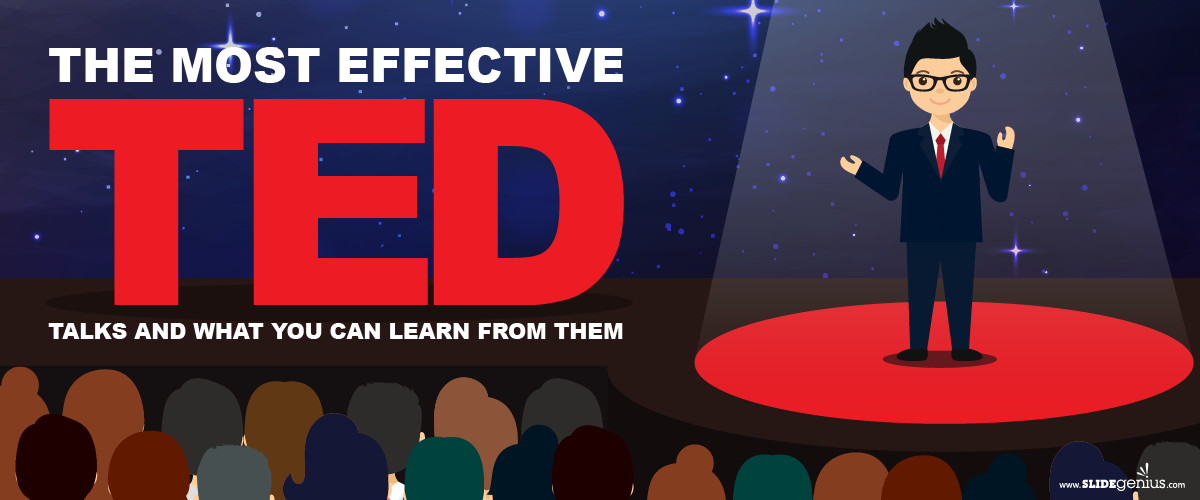Public speaking is not an innate talent that people are born with. It’s a skill that takes patience and constant practice to master. Many would agree that TED (Technology, Entertainment, Design), an organization dedicated to spreading powerful ideas, is a pacesetter in producing the best presentations in the world. TED talks have been translated to more than a hundred languages, and TED events have been held in over 145 countries. Undoubtedly, the organization sets the bar higher in organized presentations.
This massive success begs the question: What does TED do differently that it manages to blow people’s minds over and over again? The answer lies in the speakers and the ideas they spread. TED speakers come onstage armed not only with powerful concepts and inspiring words but also with effective methods to get their message across. Here are eight lessons you can learn from the most successful TED talks ever held.

1. Hook the audience with one big idea
Everything, no matter how great, starts with a tiny spark of idea. Even the most elaborate TED talks begin with a simple concept that holds promise. As Jeremy Donovan, a TEdx organizer, said, “If you had to say there was one magical element to the best TED talks, it’s that those speakers picked one really, really big idea.” When giving a presentation, you don’t want to bombard your audience with a flurry of information. Choose one specific and interesting topic, then work around it. Attack it from a unique angle and give your audience something to think about.
2. Start with an interesting opener
Don’t go onstage thinking that it’s the audience’s job to listen. You must earn the audience’s attention every time you take the limelight. The best TED speakers know this so they make their talks interesting from the moment they drop the first word.
- Begin with an anecdote. Brene Brown opened her talk, “The Power of Vulnerability,” with a story that was relevant to her point. This helped the audience understand Brown and her message.
- State an incredible fact. Dan Gilbert is no stranger to the TED stage. One of the reasons why he captivates the audience every time he speaks is that he begins with an interesting statistic that turns heads.
- Pause for ten seconds. Seth Godin advises public speakers to pause not for two, three or five seconds but for ten whole seconds to get everyone’s attention. And Godin should know since he’s one of America’s most respected marketing gurus.

3. Share a story that resonates with the audience
Everybody loves stories, especially those that appeal to the emotions. When you tell a story, make sure to not only relay the events but also the emotions you experienced. When you share genuine feelings, you establish a connection with the audience. This is exactly what Elizabeth Gilbert did in her inspiring TED talk, “Your Elusive Creative Genius.”
4. Establish rapport using humor
To establish a connection with the audience, the speaker should lower his defenses and let the audience into his personal bubble. One of the most effective ways to do this is to use humor. In the most viewed TED talk of all time, “Do Schools Kill Creativity,” Sir Ken Robinson used self-deprecating humor to make the audience feel more comfortable around him. You can apply the same principle to endear yourself to the audience and make them want to listen to your message.
5. Design your slides with care
Good speakers use pictures instead of texts to reinforce their message. Just look at Kelly McGonigal’s TED talk entitled, “How to Make Stress Your Friend.” Observe how she effectively used images to strengthen her claims. If you plan to accompany your talk with a PowerPoint presentation, make sure to do away with large chunks of text and instead focus on the audience’s visual experience. Remember, you’re already overwhelming your audience with words by simply talking; don’t tire them out by forcing them to read your slides.

6. Reinforce your point throughout the talk
Contrary to popular opinion, you should consistently repeat yourself throughout the presentation. If you establish your point over and over, your audience will eventually catch on to what you’re trying to say. This is what Richard St. John did in his short TED talk about success. He gave away the eight secrets to success while staying true to one core message: Success doesn’t come easy. You need to have the passion, the courage and the resilience to pursue it.
7. Leave your audience a gift before you go
The audience always sit in anticipation of something new to bring home. They lend their ears because they expect to be entertained or blown away by a novel idea or a fresh perspective they’ve never thought of before. Remember, although the presentation is your moment, it’s not entirely about you. You stand onstage not to bask under the spotlight but to share something that is worth your audience’s time.
The words of Robert Ballard, the explorer who discovered Titanic, are very fitting in this case. He said, “Your mission in any presentation is to inform, educate, and inspire. You can only inspire when you give people a new way of looking at the world in which they live.” Take for example Susan Cain’s “The Power of Introverts.” Cain dared to look at introversion from a different light, and the response she got was positively overwhelming.
8. Waste no one’s time
It’s common courtesy among public speakers to end their talk before the time limit. TED talks run for an average of eighteen minutes, which TED curator Chris Anderson finds “long enough to be serious and short enough to hold people’s attention.” So if you’re given thirty minutes, prepare for a presentation that runs for twenty-five minutes or less. You can allot the extra time for unforeseen events or unsolicited questions from the audience.
Public speaking is not easy, but if you follow these tips, you’ll be a few steps closer to delivering an electrifying TED-like presentation that you’ll cherish for life.
Resources:
Gallo, Carmine. “9 Public Speaking Lessons from the World’s Greatest TED Talks.” Forbes. March 4, 2014. www.forbes.com/sites/carminegallo/2014/03/04/9-public-speaking-lessons-from-the-worlds-greatest-ted-talks/#3e8ca62212ea
Haden, Jeff. “20 Public Speaking Tips of the Best TED Talks.” Inc. www.inc.com/ss/jeff-haden/20-public-speaking-tips-best-ted-talks
James, Geoffrey. “11 Public Speaking Tips from the Best TED Talks Speakers.” Inc. July 26, 2016. www.inc.com/geoffrey-james/11-public-speaking-tips-from-the-best-ted-talks-speakers.html
May, Kate Torgovnick & Ludolph, Emily. “A TED Speaker Coach Shares 11 Tips for Right Before You Go Onstage.” TED Blog. February 14, 2016. blog.ted.com/a-ted-speaker-coach-shares-11-tips-for-right-before-you-go-on-stage
Stillman, Jessica. “5 Secrets of Public Speaking from the Best TED Presenters.” Inc. November 8, 2013. www.inc.com/jessica-stillman/ted-speakers-on-presenting-public-speaking.html








